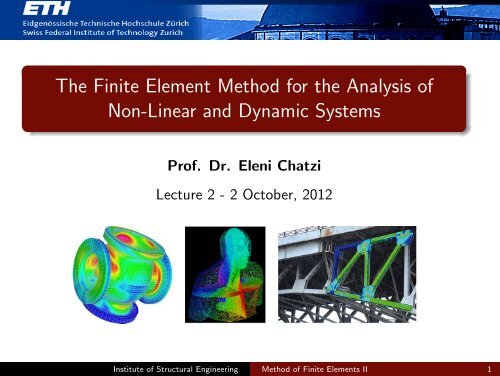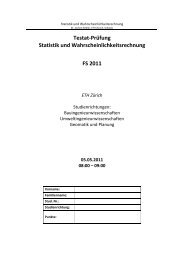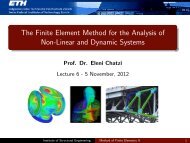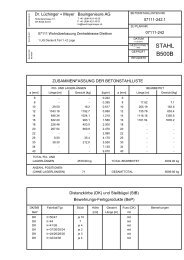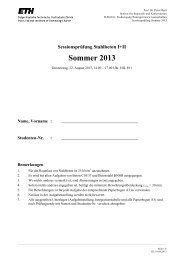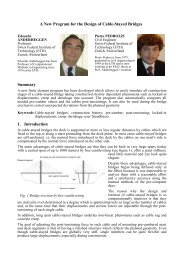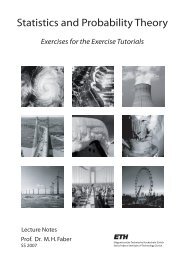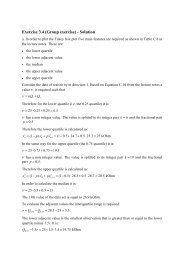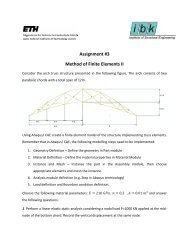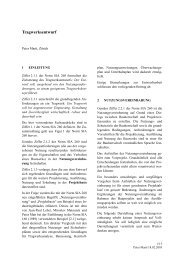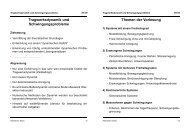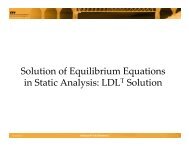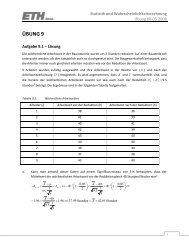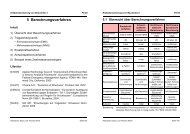The Finite Element Method for the Analysis of Non-Linear and ...
The Finite Element Method for the Analysis of Non-Linear and ...
The Finite Element Method for the Analysis of Non-Linear and ...
You also want an ePaper? Increase the reach of your titles
YUMPU automatically turns print PDFs into web optimized ePapers that Google loves.
<strong>The</strong> <strong>Finite</strong> <strong>Element</strong> <strong>Method</strong> <strong>for</strong> <strong>the</strong> <strong>Analysis</strong> <strong>of</strong><br />
<strong>Non</strong>-<strong>Linear</strong> <strong>and</strong> Dynamic Systems<br />
Pr<strong>of</strong>. Dr. Eleni Chatzi<br />
Lecture 2 - 2 October, 2012<br />
Institute <strong>of</strong> Structural Engineering <strong>Method</strong> <strong>of</strong> <strong>Finite</strong> <strong>Element</strong>s II 1
<strong>Non</strong> <strong>Linear</strong> FE - Background <strong>and</strong> Motivation<br />
<strong>Linear</strong> <strong>Analysis</strong> Assumptions<br />
Infinitesimally small displacements<br />
<strong>Linear</strong>ly elastic material<br />
No gaps or overlaps occurring during de<strong>for</strong>mations - <strong>The</strong><br />
displacement field is smooth<br />
Nature <strong>of</strong> Boundary Conditions remains unchanged<br />
Steady State Assumption<br />
No dependence on time<br />
Institute <strong>of</strong> Structural Engineering <strong>Method</strong> <strong>of</strong> <strong>Finite</strong> <strong>Element</strong>s II 2
<strong>Non</strong> <strong>Linear</strong> FE - Background <strong>and</strong> Motivation<br />
What kind <strong>of</strong> problems are not steady state <strong>and</strong> linear?<br />
Material behaves <strong>Non</strong>linearly<br />
Geometric <strong>Non</strong>linearity (ex. p-∆ effects, follower <strong>for</strong>ce)<br />
Contact Problems (Hertzian stress)<br />
Loads vary fast compared to <strong>the</strong> eigenfrequencies <strong>of</strong> <strong>the</strong><br />
structure<br />
Varying Boundary conditions (ex. freezing <strong>of</strong> water, welding)<br />
General feature:<br />
Response becomes load path dependent<br />
Institute <strong>of</strong> Structural Engineering <strong>Method</strong> <strong>of</strong> <strong>Finite</strong> <strong>Element</strong>s II 3
<strong>Non</strong> <strong>Linear</strong> FE - Background <strong>and</strong> Motivation<br />
What is <strong>the</strong> added value <strong>of</strong> being able to assess <strong>the</strong> <strong>Non</strong>linear<br />
non-steady state response <strong>of</strong> structures?<br />
Assessing <strong>the</strong>:<br />
Structural response <strong>of</strong> structures to extreme events (rock-fall,<br />
earthquake, hurricanes)<br />
Per<strong>for</strong>mance (failures <strong>and</strong> de<strong>for</strong>mations) <strong>of</strong> soils<br />
Verifying simple models<br />
Institute <strong>of</strong> Structural Engineering <strong>Method</strong> <strong>of</strong> <strong>Finite</strong> <strong>Element</strong>s II 4
<strong>Non</strong> <strong>Linear</strong> FE - Background <strong>and</strong> Motivation<br />
Collapse <strong>Analysis</strong> <strong>of</strong> <strong>the</strong> World Trade Center<br />
Institute <strong>of</strong> Structural Engineering <strong>Method</strong> <strong>of</strong> <strong>Finite</strong> <strong>Element</strong>s II 5
<strong>Non</strong> <strong>Linear</strong> FE - Background <strong>and</strong> Motivation<br />
Ultimate collapse capacity <strong>of</strong> jacket structure<br />
Institute <strong>of</strong> Structural Engineering <strong>Method</strong> <strong>of</strong> <strong>Finite</strong> <strong>Element</strong>s II 6
<strong>Non</strong> <strong>Linear</strong> FE - Background <strong>and</strong> Motivation<br />
<strong>Analysis</strong> <strong>of</strong> soil per<strong>for</strong>mance<br />
Institute <strong>of</strong> Structural Engineering <strong>Method</strong> <strong>of</strong> <strong>Finite</strong> <strong>Element</strong>s II 7
<strong>Non</strong> <strong>Linear</strong> FE - Background <strong>and</strong> Motivation<br />
<strong>Analysis</strong> <strong>of</strong> bridge response<br />
Institute <strong>of</strong> Structural Engineering <strong>Method</strong> <strong>of</strong> <strong>Finite</strong> <strong>Element</strong>s II 8
<strong>Non</strong> <strong>Linear</strong> FE - Background <strong>and</strong> Motivation<br />
Steady state problems (<strong>Linear</strong>/<strong>Non</strong>linear):<br />
<strong>The</strong> response <strong>of</strong> <strong>the</strong> system does not change over time<br />
KU = R<br />
Propagation problems (<strong>Linear</strong>/<strong>Non</strong>linear):<br />
<strong>The</strong> response <strong>of</strong> <strong>the</strong> system changes over time<br />
MÜ(t) + C ˙U(t) + KU(t) = R(t)<br />
Eigenvalue problems:<br />
No unique solution to <strong>the</strong> response <strong>of</strong> <strong>the</strong> system<br />
Institute <strong>of</strong> Structural Engineering <strong>Method</strong> <strong>of</strong> <strong>Finite</strong> <strong>Element</strong>s II 9
Introduction Introduction to <strong>Non</strong>linear to non-linear analysis analysis<br />
Classification <strong>of</strong> <strong>Non</strong>linear analyses<br />
• Classification <strong>of</strong> non-linear analyses<br />
Type <strong>of</strong> analysis Description Typical<br />
<strong>for</strong>mulation used<br />
Materially-nonlinear<br />
only<br />
Large<br />
displacements, large<br />
rotations but small<br />
strains<br />
Large<br />
displacements, large<br />
rotations <strong>and</strong> large<br />
strains<br />
Displacements <strong>and</strong><br />
rotations <strong>of</strong> fibers<br />
are large; but fiber<br />
extensions <strong>and</strong><br />
angle changes<br />
between fibers are<br />
small; stress strain<br />
relationship may be<br />
linear or non-linear<br />
Displacements <strong>and</strong><br />
rotations <strong>of</strong> fibers<br />
are large; fiber<br />
extensions <strong>and</strong><br />
angle changes<br />
between fibers may<br />
also be large; stress<br />
strain relationship<br />
may be linear or<br />
non-linear<br />
Infinitesimal<br />
displacements <strong>and</strong><br />
strains; stress train<br />
relation is nonlinear<br />
Materiallynonlinear-only<br />
(MNO)<br />
Total Lagrange (TL)<br />
Updated Lagrange<br />
(UL)<br />
Total Lagrange (TL)<br />
Updated Lagrange<br />
(UL)<br />
Stress <strong>and</strong> strain<br />
measures used<br />
Engineering strain<br />
<strong>and</strong> stress<br />
Second Piola-<br />
Kirch<strong>of</strong>f stress,<br />
Green-Lagrange<br />
strain<br />
Cauchy stress,<br />
Almansi strain<br />
Second Piola-<br />
Kirch<strong>of</strong>f stress,<br />
Green-Lagrange<br />
strain<br />
Cauchy stress,<br />
Logarithmic strain<br />
<strong>Method</strong> <strong>of</strong> <strong>Finite</strong> <strong>Element</strong>s II<br />
Institute <strong>of</strong> Structural Engineering <strong>Method</strong> <strong>of</strong> <strong>Finite</strong> <strong>Element</strong>s II 10
Introduction to <strong>Non</strong>linear analysis<br />
Swiss Federal Institute <strong>of</strong> Technology Page 21<br />
<strong>Linear</strong> Elastic<br />
Introduction to non-linear analysis<br />
L<br />
• Classification <strong>of</strong> non-linear analyses<br />
Δ<br />
P<br />
2<br />
P<br />
2<br />
σ = P / A<br />
ε = σ / E<br />
Δ= ε L<br />
σ<br />
1<br />
E<br />
ε < 0.04<br />
ε<br />
L<br />
Infinitesimal Displacements<br />
<strong>Linear</strong> elastic (infinitesimal displacements)<br />
<strong>Method</strong> <strong>of</strong> <strong>Finite</strong> <strong>Element</strong>s II<br />
Institute <strong>of</strong> Structural Engineering <strong>Method</strong> <strong>of</strong> <strong>Finite</strong> <strong>Element</strong>s II 11
Introduction to <strong>Non</strong>linear analysis<br />
Swiss Federal Institute <strong>of</strong> Technology Page 22<br />
Material <strong>Non</strong>linearity only<br />
L<br />
Introduction to non-linear analysis<br />
• Classification <strong>of</strong> non-linear analyses<br />
Δ<br />
P<br />
2<br />
P<br />
2<br />
σ = P/<br />
A<br />
σ<br />
Y<br />
σ −σY<br />
ε = +<br />
E ET<br />
ε < 0.04<br />
σ<br />
σ Y<br />
1<br />
E<br />
P / A<br />
1<br />
E T<br />
ε<br />
L<br />
<strong>Method</strong> <strong>of</strong> <strong>Finite</strong> <strong>Element</strong>s II<br />
Materially nonlinear only (infinitesimal<br />
displacements, but nonlinear stress-strain relation)<br />
Infinitesimal Displacements, but <strong>Non</strong>linear Stress Strain relation<br />
Institute <strong>of</strong> Structural Engineering <strong>Method</strong> <strong>of</strong> <strong>Finite</strong> <strong>Element</strong>s II 12
Introduction to <strong>Non</strong>linear analysis<br />
Swiss Federal Institute <strong>of</strong> Technology<br />
Large displacements, small strains<br />
Δ′<br />
y<br />
y′<br />
ε ′<br />
x′<br />
L<br />
L<br />
x<br />
ε ′ < 0.04<br />
Δ= ′ ε ′ L<br />
<strong>Linear</strong> or <strong>Non</strong>linear material behavior<br />
Institute <strong>of</strong> Structural Engineering <strong>Method</strong> <strong>of</strong> <strong>Finite</strong> <strong>Element</strong>s II 13
Introduction to <strong>Non</strong>linear to non-linear analysis analysis<br />
• Classification <strong>of</strong> non-linear analyses<br />
Large displacements, large strains<br />
<strong>Linear</strong> or <strong>Non</strong>linear material behavior<br />
Large displacements, large rotations <strong>and</strong><br />
Institute <strong>of</strong> Structural Engineering <strong>Method</strong> <strong>of</strong> <strong>Finite</strong> <strong>Element</strong>s II 14
Introduction Swiss to Federal <strong>Non</strong>linear Institute <strong>of</strong> Technology analysis<br />
Introduction to non-linear analysis<br />
Change in BC <strong>for</strong> displacement<br />
• Classification <strong>of</strong> non-linear analyses<br />
P<br />
2<br />
P<br />
2<br />
Δ<br />
Chang in boundary conditions<br />
Institute <strong>of</strong> Structural Engineering <strong>Method</strong> <strong>of</strong> <strong>Finite</strong> <strong>Element</strong>s II 15
Example: Simple Bar Structure<br />
Material <strong>Non</strong>linearity only<br />
Swiss Federal Institute <strong>of</strong> Technology<br />
Assumptions: Small displacements, strains, load is applied slowly.<br />
Area = 1cm<br />
2<br />
t u<br />
σ<br />
t R<br />
4<br />
3<br />
2<br />
1<br />
Section a Section b<br />
L = 10cm<br />
a<br />
L = 5cm<br />
b<br />
t R<br />
2 4 6 t<br />
σ Y<br />
1<br />
E<br />
1<br />
ε = 0.002<br />
Y<br />
E = 10 N / cm<br />
T<br />
7 2<br />
5 2<br />
E = 10 N / cm<br />
σ :yield stress<br />
Y<br />
ε : yield strain<br />
Y<br />
E T<br />
ε<br />
⇒ Calculate <strong>the</strong> displacement at <strong>the</strong> point <strong>of</strong> load application.<br />
Institute <strong>of</strong> Structural Engineering <strong>Method</strong> <strong>of</strong> <strong>Finite</strong> <strong>Element</strong>s II 16
Example: Simple Bar Structure<br />
Area = 1cm<br />
Section a Section b<br />
L = 10cm<br />
a<br />
t<br />
t<br />
t u t u<br />
εa<br />
= , εb<br />
=−<br />
L L<br />
a<br />
R+ σ A=<br />
σ A<br />
t t t<br />
b<br />
2<br />
T<br />
a<br />
L = 5cm<br />
b<br />
b<br />
t u<br />
t R<br />
t<br />
t σ<br />
ε = (elastic region)<br />
E<br />
t<br />
t σ −σY<br />
ε = εY<br />
+ (plastic region)<br />
E<br />
σ<br />
σ Y<br />
t R<br />
4<br />
3<br />
2<br />
1<br />
1<br />
E<br />
1<br />
E T<br />
ε<br />
ε = 0.002<br />
7 2<br />
E = 10 N / cm<br />
5 2<br />
E = 10 N / cm<br />
T<br />
σ : yield stress<br />
Y<br />
ε : yield strain<br />
2 4 6 t<br />
Δσ<br />
Δ ε = (unloading)<br />
E<br />
Y<br />
Institute <strong>of</strong> Structural Engineering <strong>Method</strong> <strong>of</strong> <strong>Finite</strong> <strong>Element</strong>s II 17
Example: Simple Bar Structure<br />
In <strong>the</strong> beginning both Sections are elastic<br />
Institute <strong>of</strong> Structural Engineering <strong>Method</strong> <strong>of</strong> <strong>Finite</strong> <strong>Element</strong>s II 18
Example: Simple Bar Structure<br />
Section A is elastic while Section B is plastic<br />
Since <strong>the</strong> stress on Section B is higher, it will yield first at time t ∗ :<br />
Unloading occurs be<strong>for</strong>e Section A yields.<br />
Institute <strong>of</strong> Structural Engineering <strong>Method</strong> <strong>of</strong> <strong>Finite</strong> <strong>Element</strong>s II 19
Introduction to <strong>Non</strong>linear <strong>Analysis</strong><br />
Conclusion from <strong>the</strong> previous example:<br />
<strong>The</strong> basic problem in general <strong>Non</strong>linear analysis is to find a state <strong>of</strong><br />
equilibrium between externally applied loads <strong>and</strong> element nodal <strong>for</strong>ces<br />
t R − t F = 0<br />
t R = t R B + t R S + t R C<br />
t F = ∑ ∫<br />
t B (m)T t τ (m) t dV (m)<br />
m<br />
t V m<br />
where R B : body <strong>for</strong>ces, R S : surface <strong>for</strong>ces, R C : nodal <strong>for</strong>ces<br />
We must achieve equilibrium <strong>for</strong> all time steps when<br />
incrementing <strong>the</strong> loading<br />
Very general approach<br />
Includes implicitly also dynamic analysis!<br />
Institute <strong>of</strong> Structural Engineering <strong>Method</strong> <strong>of</strong> <strong>Finite</strong> <strong>Element</strong>s II 20
Types <strong>of</strong> Response Diagrams<br />
Basic Types<br />
F<br />
U<br />
Institute <strong>of</strong> Structural Engineering <strong>Method</strong> <strong>of</strong> <strong>Finite</strong> <strong>Element</strong>s II 21
Types <strong>of</strong> Response Diagrams<br />
Complex Types<br />
R<br />
U<br />
Institute <strong>of</strong> Structural Engineering <strong>Method</strong> <strong>of</strong> <strong>Finite</strong> <strong>Element</strong>s II 22
Solution Algorithms <strong>for</strong> NL equations<br />
Root finding <strong>for</strong> single variable NL problems f (x) = 0<br />
Bisection <strong>Method</strong><br />
Fixed Point Iteration<br />
Assumption: f [a, b] ∈ R <strong>and</strong><br />
continuous<br />
If f (a) > 0, f (b) < 0 ⇒ a ≤ ¯x ≤<br />
b ⇒ f (¯x) = 0<br />
Write f (x) = 0 in <strong>the</strong> <strong>for</strong>m f (x) = x − q(x),<br />
<strong>the</strong> solution ¯x satisfies ¯x = q(¯x)<br />
Recurrence relation: x k+1 = g(x k )<br />
Convergence: If g ′ (x) is defined over [a, b] <strong>and</strong> a<br />
positive constant K exists with |ġ(x)| ≤ K,<br />
∀x ∈ [a, b] <strong>the</strong>n g(x) has a unique fixed point<br />
¯x ∈ [a, b].<br />
Institute <strong>of</strong> Structural Engineering <strong>Method</strong> <strong>of</strong> <strong>Finite</strong> <strong>Element</strong>s II 23
Solution Algorithms <strong>for</strong> NL equations<br />
Root finding <strong>for</strong> single variable NL problems f (x) = 0<br />
Newton (Raphson) <strong>Method</strong><br />
Secant <strong>Method</strong><br />
Defined by <strong>the</strong> recurrence relation<br />
x k+1 = x k − f(x k)<br />
f ′ (x k )<br />
terminate when |x k+1 − x k | ≤ ɛ, ɛ
Incremental <strong>Analysis</strong><br />
<strong>The</strong> basic approach in incremental analysis is:<br />
Find a state <strong>of</strong> equilibrium between externally applied loads <strong>and</strong><br />
element nodal <strong>for</strong>ces<br />
t+∆t R − t+∆t F = 0<br />
Assuming that t+∆t R is independent <strong>of</strong> <strong>the</strong> de<strong>for</strong>mations we have<br />
t+∆t R = t F + F<br />
We know <strong>the</strong> solution t F at time t <strong>and</strong> F is <strong>the</strong> increment in <strong>the</strong><br />
nodal point <strong>for</strong>ces corresponding to an increment in <strong>the</strong><br />
displacements <strong>and</strong> stresses from time t to time t + ∆t. This we can<br />
approximate by<br />
F = t KU<br />
Institute <strong>of</strong> Structural Engineering <strong>Method</strong> <strong>of</strong> <strong>Finite</strong> <strong>Element</strong>s II 25
Incremental <strong>Analysis</strong><br />
Newton-Raphson <strong>Method</strong><br />
Assume <strong>the</strong> tangent stiffness matrix:<br />
t K = ∂t F<br />
∂ t U<br />
We may now substitute <strong>the</strong> tangent stiffness matrix into <strong>the</strong><br />
equilibrium relation<br />
t KU = t+∆t R − t F<br />
which gives us a scheme <strong>for</strong> <strong>the</strong> calculation <strong>of</strong> <strong>the</strong> displacements:<br />
t+∆t U = t U + U<br />
<strong>The</strong> exact displacements at time t + ∆t correspond to <strong>the</strong> applied<br />
loads at t + ∆t, however we only determined <strong>the</strong>se approximately as<br />
we used a tangent stiffness matrix thus we may have to iterate to<br />
find <strong>the</strong> solution.<br />
Institute <strong>of</strong> Structural Engineering <strong>Method</strong> <strong>of</strong> <strong>Finite</strong> <strong>Element</strong>s II 26
Incremental <strong>Analysis</strong><br />
We may use <strong>the</strong> Newton-Raphson iteration scheme to find <strong>the</strong><br />
equilibrium within each load increment<br />
t+∆t K (i−1) ∆U (i) = t+∆t R − t∆t F (i−1)<br />
(out <strong>of</strong> balance load vector)<br />
with Initial Conditions<br />
t+∆t U (i) = t+∆t U (i−1) + ∆U (i)<br />
t+∆t U (0) = t U; t+∆t K (0) = t K; t+∆t F (0) = t F<br />
Institute <strong>of</strong> Structural Engineering <strong>Method</strong> <strong>of</strong> <strong>Finite</strong> <strong>Element</strong>s II 27
<strong>The</strong> first two analysis types, although significantly simplified, can lead to valuable conclusions<br />
concerning <strong>the</strong> behavior <strong>of</strong> <strong>the</strong> structure <strong>and</strong> <strong>the</strong> possible collapse mechanism. <strong>The</strong> applied procedure<br />
can be described in brief as follows. In <strong>the</strong> case <strong>of</strong> 2-D analysis <strong>the</strong> structure is assumed to consist <strong>of</strong> a<br />
finite number <strong>of</strong> nodes interconnected by a finite number <strong>of</strong> elements. <strong>The</strong> types <strong>of</strong> elements have<br />
been It may described expensive in section 3. toIn calculate <strong>the</strong> case <strong>of</strong> <strong>the</strong> 3-D tangent analysis <strong>the</strong> stiffness structure matrix. is assumed Into <strong>the</strong> consist <strong>of</strong> <strong>the</strong><br />
a<strong>for</strong>ementioned Modified Newton-Raphson 2-D frames, assuming a rigid iteration diaphragm scheme assemblage it is <strong>of</strong> only <strong>the</strong>ir calculated horizontal d<strong>of</strong>’s in <strong>the</strong> per floor<br />
slab. Loads may be applied at <strong>the</strong> nodes or along <strong>the</strong> elements. In both cases though, <strong>the</strong>y are<br />
trans<strong>for</strong>med beginning to nodal <strong>of</strong> each loads. new load step<br />
Modified Newton (Raphson)<strong>Method</strong><br />
Figure 5. Modified Newton Raphson <strong>Method</strong><br />
In <strong>the</strong> quasi-Newton iteration schemes <strong>the</strong> secant stiffness matrix is used<br />
instead <strong>of</strong> <strong>the</strong> tangent matrix<br />
After <strong>the</strong> <strong>for</strong>mation <strong>of</strong> <strong>the</strong> stiffness matrix <strong>the</strong> equilibrium equations are solved by an efficient<br />
algorithm based on <strong>the</strong> Gaussian elimination method. <strong>The</strong> structure stiffness is stored in a b<strong>and</strong>ed <strong>for</strong>m<br />
Institute <strong>of</strong> Structural Engineering <strong>Method</strong> <strong>of</strong> <strong>Finite</strong> <strong>Element</strong>s II 28
Simple Bar Example - Revisited<br />
t t () i t+Δ t t+Δt ( i− 1) t+Δt ( i−1)<br />
( Ka + Kb) Δ u = R−( Fa − Fb<br />
)<br />
t+Δ t () i t+Δt ( i−1) () i<br />
with initial conditions<br />
u = u;<br />
F = F F = F<br />
t+Δ t (0) t t+Δ t (0) t t+Δt (0) t<br />
a a b b<br />
t<br />
u = u +Δu<br />
t<br />
t<br />
CA t CA<br />
Ka<br />
= ; Kb<br />
=<br />
L L<br />
a<br />
if section is elastic<br />
t ⎧=<br />
E<br />
C ⎨<br />
⎩= ET<br />
if section is plastic<br />
b<br />
Institute <strong>of</strong> Structural Engineering <strong>Method</strong> <strong>of</strong> <strong>Finite</strong> <strong>Element</strong>s II 29
Simple Bar Example - Revisited<br />
Load step 1: t = 1:<br />
( K + K ) Δ u = R− F − F<br />
0 0 (1) 1 1 (0) 1 (0)<br />
a b a b<br />
⇓<br />
2×<br />
10<br />
Δ u = = 6.6667×<br />
10<br />
7 1 1<br />
10 ( + )<br />
10 5<br />
Iteration 1: ( i = 1)<br />
4<br />
(1) −3<br />
u = u +Δ u = 6.6667×<br />
10<br />
1 (1) 1 (0) (1) −3<br />
1 (1)<br />
1 (1) −4<br />
εa<br />
= = ×<br />
La<br />
1 (1)<br />
b<br />
u<br />
b<br />
6.6667 10 < ε (elastic section!)<br />
1 (1)<br />
u<br />
−3<br />
ε = = 1.3333×<br />
10 < εY<br />
(elastic section!)<br />
L<br />
F<br />
= 6.6667× 10 ; F = 1.3333×<br />
10<br />
1 (1) 3 1 (1) 4<br />
a<br />
b<br />
0 0 (2) 1 1 (1) 1 (1)<br />
( Ka Kb) u R Fa Fb<br />
0<br />
Y<br />
Convergence in one iteration!<br />
1 −3<br />
+ Δ = − − = u = 6.6667×<br />
`10<br />
Institute <strong>of</strong> Structural Engineering <strong>Method</strong> <strong>of</strong> <strong>Finite</strong> <strong>Element</strong>s II 30
Simple Bar Example - Revisited<br />
Load step 2: t = 2 :<br />
( K + K ) Δ u = R− F − F<br />
1 1 (1) 2 2 (0) 2 (0)<br />
a b a b<br />
⇓<br />
(4× 10 ) − (6.6667× 10 ) − (1.333×<br />
10 )<br />
Δ u = = 6.6667×<br />
10<br />
7 1 1<br />
10 ( + )<br />
10 5<br />
Iteration 1: ( i = 1)<br />
4 3 4<br />
(1) −3<br />
u = u +Δ u = 1.3333×<br />
10<br />
2 (1) 2 (0) (1) −2<br />
ε = 1.3333×<br />
10 < ε (elastic section!)<br />
2 (1) −3<br />
a<br />
ε<br />
2 (1) −3<br />
b<br />
Y<br />
= 2.6667×<br />
10 > ε (plastic section!)<br />
Y<br />
F = 1.3333× 10 ; F = ( E ( ε − ε ) + σ ) A= 2.0067×<br />
10<br />
1 (1) 4 1 (1) T 2 (1) 4<br />
a b b Y Y<br />
( K + K ) Δ u = R− F − F ⇒Δ u = 2.2×<br />
10<br />
1 1 (2) 2 2 (1) 2 (1) (2) −3<br />
a b a b<br />
Institute <strong>of</strong> Structural Engineering <strong>Method</strong> <strong>of</strong> <strong>Finite</strong> <strong>Element</strong>s II 31
Simple Bar Example - Revisited<br />
<strong>The</strong> procedure is repeated <strong>and</strong> <strong>the</strong> results <strong>of</strong> successive iterations are<br />
tabulated in <strong>the</strong> accompanying table.<br />
Institute <strong>of</strong> Structural Engineering <strong>Method</strong> <strong>of</strong> <strong>Finite</strong> <strong>Element</strong>s II 32


